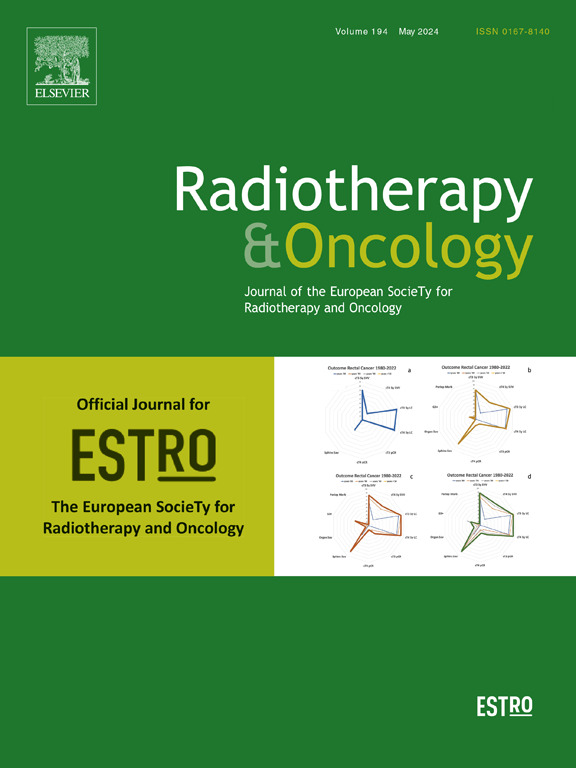基于知识的规划,对 10 个不同癌症部位进行全自动放射治疗规划。
IF 4.9
1区 医学
Q1 ONCOLOGY
引用次数: 0
摘要
目的:放射治疗计划非常复杂,计划人员之间和计划人员内部可能存在严重的不一致性,计划时间和计划质量也存在差异。基于知识的计划(KBP)是一种工具,可用于有效生成高质量、一致、临床可接受的计划,且不受计划人员技能和经验的影响。在这项研究中,我们创建并验证了多个临床可接受的全自动 KBP 模型,目的是在无需用户干预的情况下创建 VMAT 计划:方法:使用一家机构的高质量临床计划配置了十个 KBP 模型。方法:使用来自单一机构的高质量临床计划配置了十个 KBP 模型,然后通过整合可编写脚本的计划结构、计划创建和计划优化,使其成为全自动系统的一部分。通过定量(模型统计)和定性(剂量-体积直方图估算审查)分析,对这些模型进行了验证和确认。医生对 KBP 生成的计划进行了审查,并对临床可接受性进行了评级:结果:为肛门直肠、膀胱、乳房/胸壁、宫颈、食道、头颈部、肝脏、肺/纵隔、前列腺和前列腺结节治疗部位创建了自动规划模型。所有模型都已成功创建为全自动系统的一部分,无需人工干预即可创建完全优化的计划。医生审查表明,在所有 KBP 生成的计划中,平均 88% 的计划 "原样可接受",98% 的计划 "稍作编辑后可接受":多个治疗点的 KBP 模型被用作生成全自动、高效、一致、高质量和临床上可接受的计划的基础。这些计划不需要人工干预,表明这项工作有可能对治疗计划工作流程产生重大影响。本文章由计算机程序翻译,如有差异,请以英文原文为准。
Knowledge-based planning for fully automated radiation therapy treatment planning of 10 different cancer sites
Purpose
Radiation treatment planning is highly complex and can have significant inter- and intra-planner inconsistency, as well as variability in planning time and plan quality. Knowledge-based planning (KBP) is a tool that can be used to efficiently produce high-quality, consistent, clinically acceptable plans, independent of planner skills and experience. In this study, we created and validated multiple clinically acceptable and fully automatable KBP models, with the goal of creating VMAT plans without user intervention.
Methods
Ten KBP models were configured using high quality clinical plans from a single institution. They were then honed to be part of a fully automatable system by incorporating scriptable planning structures, plan creation, and plan optimization. These models were verified and validated using quantitative (model statistics) and qualitative (dose-volume histogram estimation review) analysis. The resulting KBP-generated plans were reviewed by physicians and rated for clinical acceptability.
Results
Autoplanning models were created for anorectal, bladder, breast/chest wall, cervix, esophagus, head and neck, liver, lung/mediastinum, prostate, and prostate with nodes treatment sites. All models were successfully created to be part of a fully automated system without the need for human intervention to create a fully optimized plan. The physician review indicated that, on average, 88% of all KBP-generated plans were “acceptable as is” and 98% were “acceptable after minor edits.”
Conclusion
KBP models for multiple treatment sites were used as a basis to generate fully automatable, efficient, consistent, high-quality, and clinically acceptable plans. These plans do not require human intervention, demonstrating the potential this work has to significantly impact treatment planning workflows.
求助全文
通过发布文献求助,成功后即可免费获取论文全文。
去求助
来源期刊

Radiotherapy and Oncology
医学-核医学
CiteScore
10.30
自引率
10.50%
发文量
2445
审稿时长
45 days
期刊介绍:
Radiotherapy and Oncology publishes papers describing original research as well as review articles. It covers areas of interest relating to radiation oncology. This includes: clinical radiotherapy, combined modality treatment, translational studies, epidemiological outcomes, imaging, dosimetry, and radiation therapy planning, experimental work in radiobiology, chemobiology, hyperthermia and tumour biology, as well as data science in radiation oncology and physics aspects relevant to oncology.Papers on more general aspects of interest to the radiation oncologist including chemotherapy, surgery and immunology are also published.
 求助内容:
求助内容: 应助结果提醒方式:
应助结果提醒方式:


